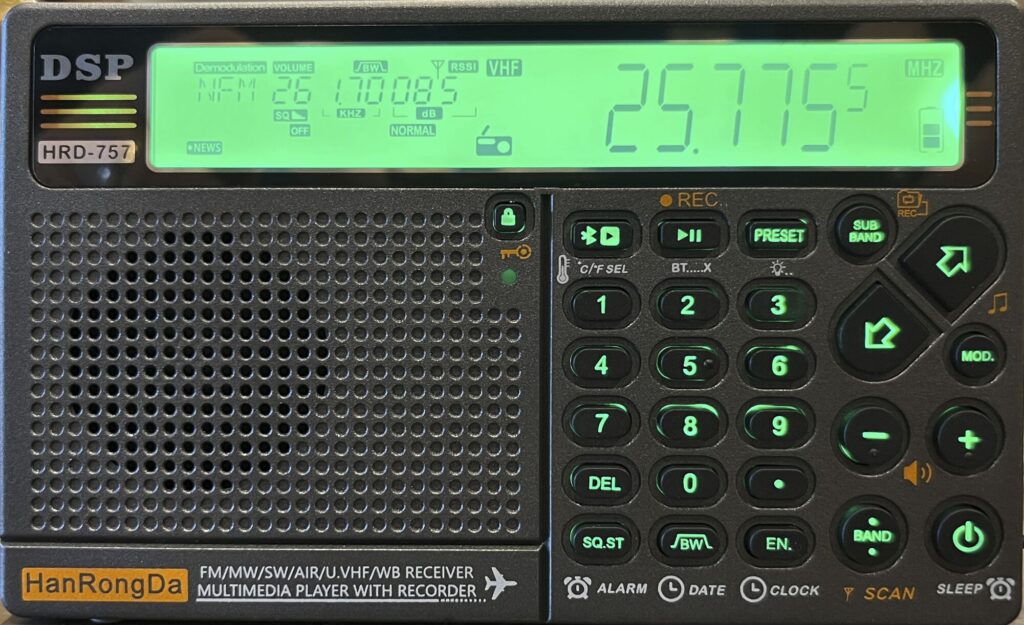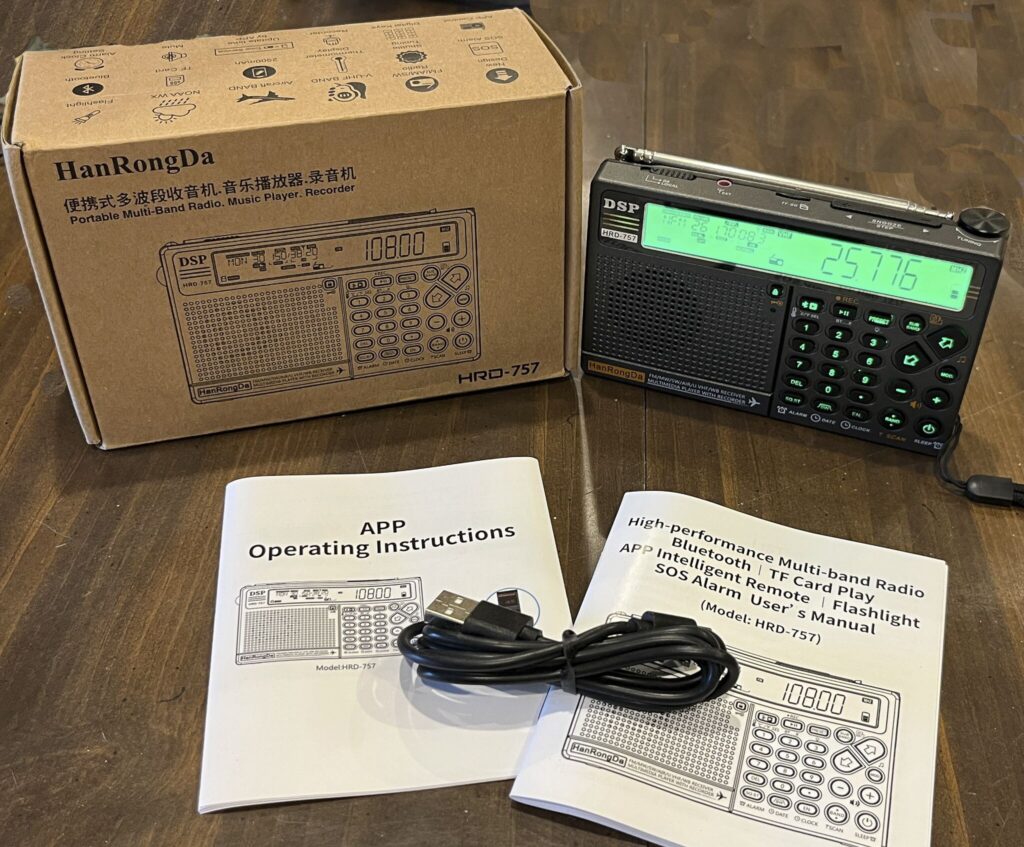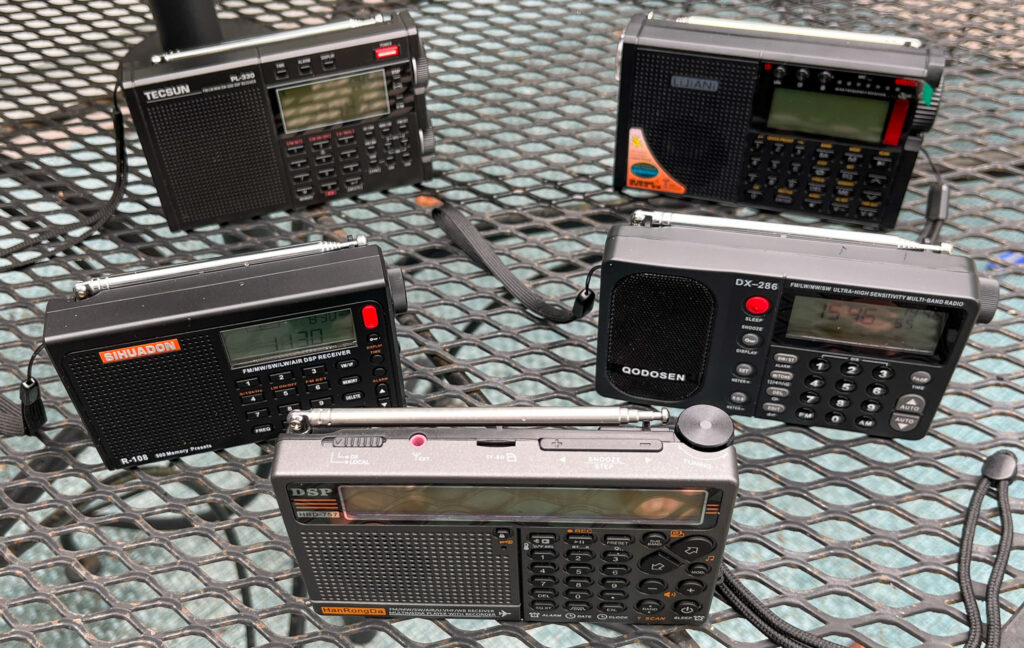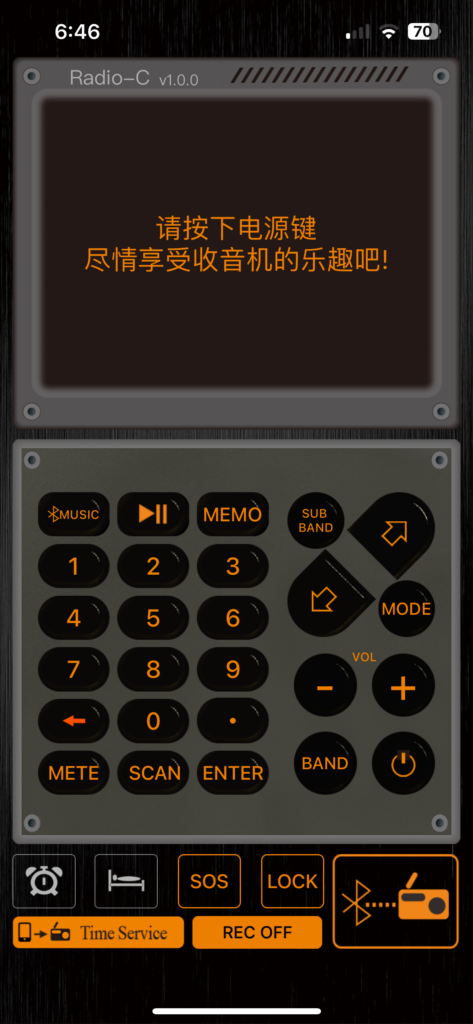So welcome to the HanRongDa HRD-757 (aka Raddy RF757, Zhiwhis ZWS-757), what appears to be a relatively new entry in the Swiss Army Knife™ radio class (see feature list below), and my first radio with UHF coverage up to 999 MHz. It completed its FCC type acceptance testing on March 1, 2024.

I got my HRD-757 from AliExpress at the Jai Ping Bo store. It cost $71.02 including sales tax and shipping to the US. It took 15 days to arrive (1 day late). It’s around $90 with a coupon on Amazon (the Raddy and ZHIWHIS logo versions). The Amazon versions have different packaging and accessories. Update 8/4/2024: the ZHIWHIS version with coupon is around $81.
Unboxing
The radio comes with:
- Box
- Radio
- Radio Manual
- App Manual
- USB-C charging cable
- 2500 mAh 18650 battery

The radio came with the battery installed and the radio key lock setting on. The correct time and date were already set, but for a 12-hour later time zone.
Look and feel
I picked the green display option over amber. It appears that the Raddy and Zhiwhis variants only come in amber. The two photos above nicely show the illuminated buttons feature, but the display is actually much sharper.
The radio looks bigger than it is. It must be the wide display that itself is wider than other radio displays, and it’s reduced height makes more space available for the keys, making the radio look taller. In fact size is almost identical to the Tecsun PL-330 and LiJiANi Rd239, a good size for a travel radio. The second observation is that the antenna is on the thin side, like the Rd239, a disappointment. The antenna is 61 cm. The radio feels a little heavy; the manual says 250 grams with battery.
The battery itself, an 18650, is wedged in very tightly. The included battery is not a button top, although a button top battery I put in it worked OK. The battery compartment and speaker port protrude from the case and as a result the radio cannot lay flat on its back, but of course there is a kickstand.
The vertical tuning knob in the upper right corner is a bit unusual. I found the knob comfortable and it worked well in that position. There is a bit of a problem with the knob if you’re holding the radio and using the arrow buttons to tune the radio. Your finger easily turns the knob by accident. This is not a big deal because the radio has a special lock function just for disabling this knob.
There are no controls on the sides of the radio (volume is controlled by front panel buttons). The flashlight/SOS alarm switch is on the back of the radio. There is a Local/DX switch on the top along with the external antenna jack, TF card slot and a Snooze button.
I like the wide display format with a very prominent frequency display, and lighted buttons is a cool feature. The calendar is nice too.
The radio reminds me of two other radios, the Raddy RF75A (HRD-787) and LiJiANi Rd239, both with extended frequency coverage and similar operational concepts. The RF75A is also controlled by the same app, Radio-CT on iOS and Radio-C on Android. The HRD-757 is similar enough to the Rd239 that I am using its manual to help me decipher the HRD-757 manual.
The manual is awful, as are other manuals from this manufacturer. I do not understand how a company can put so much effort into a product only to ruin the user experience with a half-finished manual. If I end up using the radio a good bit, I may write my own manual, as I did with the XHDATA D-808.
The feel of the buttons is superior. The clicks are reliable and confident.
Features
Here is a comparable features table with the HanRongDa HRD-757 alongside the LiJiANi Rd239, Qodosen DX-286, Tecsun PL-330 and Sihuadon R-108.

| Feature | HRD-757 | Rd239 | DX-286 | PL-330 | R-108 |
|---|---|---|---|---|---|
| LW | Y | Y | Y | ||
| MW | Y | Y | Y | Y | Y |
| Ext MW Ant | Y | Y1 | |||
| SW (MHz) | 3.2 – 30 | 3.2 – 30 | 1.7111 – 27 | 1.711 – 30 | 1.711 – 30 |
| Ext SW Ant Jack | Y | Y | Y | Y | Y |
| SW Bandwidth | 5 | 5 | 3, 4, 6, 8 | 2.5, 3.5, 5 | 1, 2, 3, 4, 6 |
| SW Step | 5 | 5 | 1,5 | 0.1,1,5 | 1,5 |
| FM | Y | Y | Y | Y | Y |
| FM RDS | Y | ||||
| AIR | Y | Y | Y | ||
| WB | Y | Y | |||
| VHF | Y | Y | |||
| UHF | Y | ||||
| ATS Mem. | 1000 | 540 | 1000 | 9650 | 500 |
| SSB | Y | ||||
| App control | Y | ||||
| Thermometer | Y | Y | |||
| MP3 Play | Y | Y | |||
| AUX in | Y | ||||
| Radio Record | Y | Y | |||
| AUX Record | Y | ||||
| Battery | 18650 | BL-5C | 18650 | BL-5C | BL-5C |
| Clock Always Visible | Y | Y | Y | ||
| Calendar | Y | ||||
| Size (mm) | 138 x 87 x 31 | 138 x 85 x 28 | 134 x 76 x 30 | 139 x 86 x 26 | 118 x 73 x 27 |
| Bluetooth | Y | Y | |||
| Flashlight | Y | Y | |||
| Reading light | Y | ||||
| Backlit keys | Y | Y | |||
| PC Speaker | Y | Y | |||
| PC card access | Y | Y | |||
| Charge | USB-C | USB-C | USB Mini | USB Mini | USB-Mini |
| Antenna (cm) | 61 | 60 | 49 | 49 | 49 |
| Manual grade | D- | B | A- | A | A |
| Display color | Green | Amber | White | Amber | Amber |
Operation
Readers of Blog or Die! have likely noticed that I put a lot of value in a radio with good operational characteristics. I don’t like radios that require extra key presses for normal frequency entry once the band is established. The Tecsun radios, the Qodosen radios and the Eton Elite Executive have exemplary frequency entry. The HRD-757 adopts the annoying extra key presses that I dislike so much on the XHDATA D-808, Sangean ATS-405 and LiJiANi Rd239.
The radio arrived with temperature and MW step values suitable for most of the world, but not North American; this led to my first experience actually trying to look something up in the manual to see how to do it.
The inability to search in the manual PDF (because of its crazy character set) makes finding things difficult. The fact that the page numbers in the table of contents are wrong doesn’t help. MW step is not mentioned in the table of contents. The manual tells you pretty early that the MW step is tied to the FM band range, but not how to set that. I guess I was lucky in that the setting was on Page 5. In “time mode” (the state between on and off), long press the SUB BAND button and then use the arrow keys to pick the range, specifically 87.0 – 108 MHz. Temperature scale is a separate setting.
I had to read to page 7 where manual says:

OK, so how does one get into that mode? It appears that one first has to get the radio into Time Mode with temperature displayed. I accomplished that by pressing the power on button once, then pressing the button showed above until the temperature was displayed (it switches between temperature and day of the week). Then a long press picked the temperature scale, or so it appeared at the time.
Memory system
Product literature says there are 1000 memories, 200 for each band: MW, FM, SW, V.UHF and AIR. The memory location is designated with a 3-digit number. There is a PRESET button that when short pressed allows entry of the memory location within band. Memory slots are not divided into pages, a good thing. The arrow keys can also scroll through the presets.
ATS Scans include all frequencies on all short wave bands, not just the international shortwave frequencies. A full short wave band scan takes a long time, 11 minutes, 36 seconds, the longest of any radio I’ve tested.
The App
I’ve used the Radio C / Radio CT app before on the Raddy RF75A and it works well. It’s easy to set up, just press the BT button on the radio and then pair it with your phone. One really nice feature is automatic setting of the date and time(unless you want UTC). One button press on the phone sets the radio value. The radio keypad looks a lot like the app keypad. The app provides a little more information such as the sound file name being played from the TF card. When picking an equalization mode, the name of the mode is displayed in the app instead of just a number on the radio.
After setting the time, the app gave me this message:
Performance
MW
A quick look at MW suggested that the radio wasn’t very good on MW. MW seemed a bit strange in that it seemed to mute on frequencies with no stations, rather than hissing. But overall I would rank the HRD-757 among the very worst MW radios I have ever tested, getting only 4 stations in my daytime band scan.
FM
An ATS scan indoors stored 51 stations indoors in a less than optimal location, and a manual daytime scan outdoors received 77, among the best results I’ve seen.
SW
CFRX in Toronto, 400 miles from me, is my go to station for daytime testing. It’s not very strong, but it is very consistent. I picked it up weakly this afternoon. I listened to a weak signal from China Radio and compared reception alongside my Tecsun PL-330. Here’s the video.
One significant issue seemed to be a few birdies. More on that after further testing.
Weather
All weather radios I’ve tested receive the local NOAA station on 164.450 MHz. The very best ones sometimes get two others. The HRD-757 received my local station well, and two others with some distortion. The next weather alert test won’t be until next week.
AIR / VHF / UHF
I don’t have a test procedure for these. I did turn on AIR band and received some transmissions. An attempt to receive some 2 meter ham transmissions didn’t yield anything.
Audio
I really wondered about the advertising:
All radios I’ve encountered with MP3 play capability also have a rudimentary equalizer setting that doesn’t work with the radio, only the TF card play. That’s not true there here; the equalizer, controlled by “MOD” button, gives 7 different tone settings (separate from the MP3 settings) that work with the radio.
My first impression of the audio was that it was tinny with significant high frequency hiss, but then I tuned to WWV and I could feel the 100 Hz subcarrier, so there is bass. That was before I discovered that the equalizer settings worked with the radio. Some settings cut back on the treble and make it sound better. With headphones (not included) it sounded good, like most radios.
Recording worked OK. Like other radios with this feature, it cannot be tuned to a different station while recording, and like other radios, the recordings are not time stamped on the memory card. All recordings have the default value of 11:13 PM on 12/29/2013.
When connected to the computer, the HRD-757 becomes a PC USB speaker, and I was impressed with the sound clarity playing some commercial recordings. The computer can see the files on the radio’s TF card and they can be copied and deleted; however, I would not recommend loading sound files onto the radio this way. The transfer speed was between 500 and 700 kb/s compared to around 10 mb/s with the card plugged into a USB/TF card adapter connected to the same USB port.
Problems
Bugs
I discovered two bugs so far. One is that the temperature scale is not retained. One can switch the scale, but the next time the radio is turned on, it reverts to Centigrade. The other problem is that when the radio is turned on and the Weather band selected, it’s always tuned to 162.400, not the last weather frequency listened to.
Shortcomings
One shortcoming appears to be birdies on shortwave when using the telescopic antenna. I need more testing. It reminds me a lot of the HanRongDa HRD-701. I also received local broadcast signals on the shortwave band in an urban setting.
Band switching is tedious. After pressing the BAND button, the radio takes some time to switch to the next band and if you have several BANDs before the one you want, you might click too many times and the switching eventually catches up and may overshoot, leaving you to have to switch them all again.
The radio has a raspy buzzing noise on the lower shortwave bands, probably due to the display electronics. The noise is stronger when the DX – Local switch is in the local position.
AIR band has a squelch feature, but there’s no way to set the sensitivity (at least not in the manual). It does allow stronger signals to be heard, but not all listenable ones.
As I wrote above, MW performance is abysmal.
The terribly written, incomplete, poorly indexed and non-searchable manual is a major shortcoming. There are things I would like to know and things I would like to try, but to find how to do them requires starting at the beginning and reading until something sounds like it might be the thing, and then trying to figure out what it’s saying. Page numbers in the skimpy table of contents don’t match page numbers in the manual body.
When changing the battery, the time setting is lost. And with ALL that display space, I’m disappointed that the clock is not visible when the radio is on, nor when the radio is off — only shown in the TIME state between off and on. Time can be easily set through the app, but only local time, not UTC.
Conclusion
I’m not excited about the HRD-757. The exceptionally poor MW performance is a downer, the awful manual, and birdies on shortwave prevent me from recommending it, particularly at this premium price level. My early model has a couple of firmware bugs.
Shortwave is reasonably sensitive. FM sounds good and receives stations alongside my best FM receivers. The App is cool (even if some of it is in Chinese), but it’s not a radio for the radio enthusiast because it lacks SSB, RDS, coverage between 1.711 and 3.2 MHz, bandwidth control and channel spacing control. Also the birdies and overload is a problem for shortwave. Scanner radios are much better suited for the typical brief VHF/UHF transmissions.
This radio may be a candidate for my car next radio. Presently I have the Qodosen SR-286 in the car, but it lacks one feature that I might need on the road, weather band. Formerly I had the Raddy RF75A, Degen DE15 and LiJiANi Rd239 in that capacity. The flashlight helps, although I carry a separate flashlight in the car.
More …
I’ve published another review article featuring the HRD-757, Attack of the Swiss Army Knife™ Radios. It also includes the Tecsun PL-330 as a reference. It has more shortwave videos. The 757 is also added to the omnibus article on Radio Memory Systems.
I have another article planned in the short term with the HRD-757, a head to head with the Tecsun PL-330 focusing on reception. I also plan to add this radio to my previous Thunderous Clash of the Weather Radios post.




 [robot emoji] symbol. Content comes most often from Microsoft Copilot, bit may also come from Perplexity, ChatGPT or Deep Seek.
[robot emoji] symbol. Content comes most often from Microsoft Copilot, bit may also come from Perplexity, ChatGPT or Deep Seek.
Thank you Kevin. You saved me $70 for sure! I am using crapy HRD-737 and buggy HRD-747 so I though about higher level from them but …no way thanks to your review.
I will stay with my D-808…
Regards,
Petr
Hi
Thanks so much Kevin! Great review.
Although I miss some more info on AIR VHF UHF. The Quansheng UV-K5 also has a BK4819 and the fw is famous for its bad AGC for AM. Strong signals are impossible to listen to. OEFW repaired this. I think I have read in this review that this might be a problem with the 757 as well. I would really like to know before buying.
Is it possible to free choose your demodulation on very band? Eg AM on 138-144MHz? Or AM on 350MHz?Or WFM outside 88-108MHz? Or even NFM on SW (may sounds ridiculous but sometimes nice for SSB).
What about squelch, what about scanning VHF?
Nice receiver but if the reception possibilities on AiR and VHF are unknown and there is no SSB there’s not very much RX fun…
Actually Curious to these few questions…
Hello, how about firmware upgrading of HRD-757?
I’ve not seen anything about upgrading the firmware.